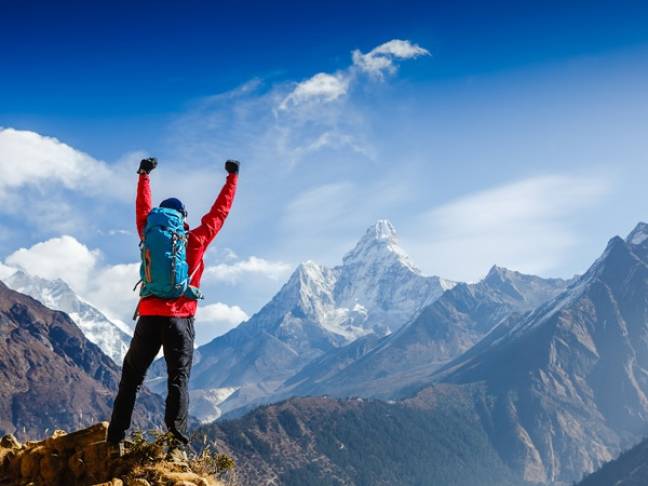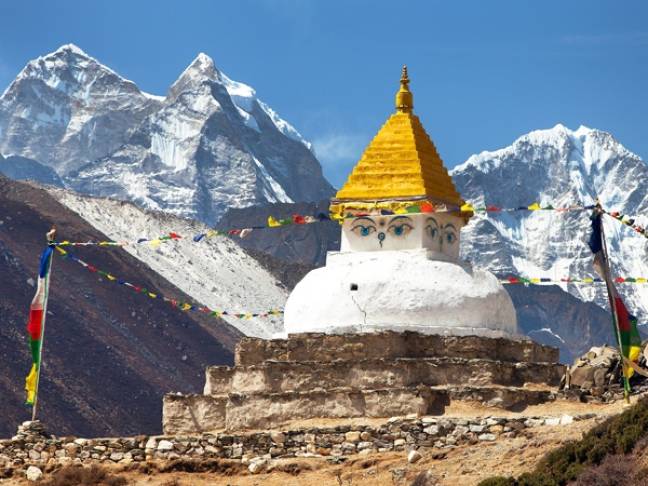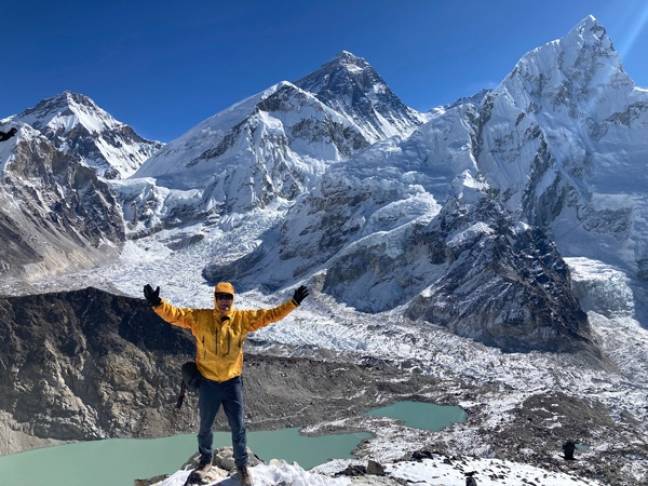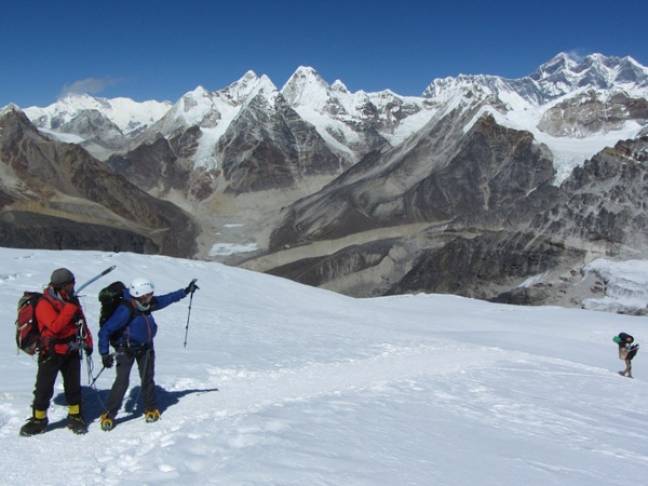Trekking Guide to the Everest Region
Known also as the Solo Khumbu, the towering mountains of the Everest region are unrivalled in their sheer scale and majesty. Most routes in the Everest region lead to Everest Base Camp, however there are side trails to explore and more remote paths to discover as well as challenging trekking peaks to climb.
Whatever trail you follow though, you will soon be immersed in the austere beauty of this awe inspiring trekking region.


The Everest Region
Where is it?
The Everest region is in northeastern Nepal. The largest town of the region is Namche Bazaar and it is also home to the famous Buddhist monastery at Thyangboche where the annual Mani Rimdu festival is held.
How to get there
Virtually all treks in the Khumbu begin with a flight from Kathmandu to the small town of Lukla. The flight takes about 45 minutes and gives glorious views of the Himalaya.
When to go
March and April in the spring and October and November in the autumn are the prime months for trekking in the Everest region. It is also possible to trek to Base Camp in December when the paths are quieter, although it can be pretty chilly at this time of the year. Trails can certainly be busy during the spring and autumn but the warm days, clear views and camaraderie with other trekkers in the tea houses and lodges along the route, make it a great time to trek.
The Mountains of the Everest Region
At 8,848m Mount Everest is, of course, the star of the show and you may be lucky enough to see expeditions preparing for their summit attempts if you trek to Base Camp in the spring. However, this is a region blessed with a multitude of soaring peaks such as Lhotse, Nuptse and Makalu, although it is perhaps Ama Dablam that is the most beautiful of them all. Whichever Everest trek you choose, you will undoubtedly enjoy spectacular views of numerous Himalayan mountains.
The people of the Khumbu
This is the homeland of the Sherpa people who are renowned for their immense fortitude and strength, as well as their wonderfully friendly disposition. They are predominantly Buddhist and earn their income primarily from tourism and climbing expeditions. Sherpa Tenzing Norgay is still the most famous of all Sherpas having successfully summited Everest with Sir Edmund Hillary in 1953.


Treks in the Everest region
Classic Tea House Treks
For those who want to tackle the classic route to Everest Base Camp, or perhaps go further still, whilst staying in tea houses en route.
A truly world class trek through the heart of Sherpa country to reach the base of Mount Everest. The trek takes 18 days, ensuring excellent acclimatisation, and follows the route from Lukla to Namche Bazaar to Thyangboche Monastery and on to Base Camp. There is also an ascent of the small peak of Kala Pattar, opposite Base Camp, which gives spectacular views of Everest. Accommodation is in traditional tea houses.
Everest Base Camp & Gokyo Lakes
This is a longer variant of the classic trek to Everest Base Camp. It takes 10 days of steady trekking to reach Base Camp, before crossing the Cho La pass to reach the dazzling turquoise lakes of Gokyo. There is also an ascent of Gokyo R at 5,483i for even more jaw-dropping, panoramic views. Tea houses provide friendly, welcoming accommodation along the way.
In Style Treks
The ideal way to enjoy trekking in the Everest region for those who like a few home comforts to help them on their way.
Using a combination of super-comfy trekking lodges and the best tea houses on the trail, this version of the classic trek to Everest Base Camp provides all the reward of the original trek, but definitely 'in style' with en suite rooms, hot running water and full service dining. There is also the added bonus of a day trek to Ama Dablam Base Camp and Dwarika's luxurious heritage hotel in Kathmandu.
Luxury Lodges to Ama Dablam Base Camp
Using the best lodges in the Khumbu, this trek leads from Lukla through some of the prettiest Sherpa villages and most spectacular mountain scenery, to reach the foot of Ama Dablam, often considered the most beautiful mountain in the region. The four luxury lodges are set in superb locations with glorious views and provide an unrivalled level of service, food and comfy en suite rooms.
Not sure whether you want to trek in the Annapurnas or the Everest region? Well this 17 day holiday means you can do both - and in style. You first fly to Pokhara in the Annapurnas for five days of trekking through the verdant terraced foothills before flying to Lukla, via Kathmandu, for another five days on trek reaching as far as Namche Bazaar and Thyangboche from where there are wonderful views of Everest itself. You stay in the best trekking lodges in both regions as well as Dwarika's five star hotel in Kathmandu.


Treks for longer than three weeks
If you've got more than three weeks for your holiday not only can you get to Base Camp but you can go much further. You could trek rather than fly into Lukla or go well off the more popular trails into the high passes beyond Base Camp.
Long Trek to Everest Base Camp
Take the long and leisurely approach to Everest following in the footsteps of the original Everest pioneers. Instead of flying into Lukla you drive out of Kathmandu to the village of Dhap then begin your trek, taking 15 days to reach Base Camp. Before joining the main route to Everest at Lukla, you'll pass through delightful Sherpa villages who see few trekkers and you'll enjoy a sunrise view from Pikey Peak said, by Edmund Hillary, to be his favourite in all Nepal.
This is a rare off-the-beaten-track route in the Everest region that goes far beyond Everest Base Camp through remote valleys and over high passes with unrivalled mountain scenery from start to finish.
Trekking Peaks
The ultimate challenge in the Everest region
Although this is Nepal’s highest trekking peak it presents a relatively straightforward challenge for the experienced trekker or novice mountaineer. There's a long trek in, away from the well-known Everest routes, providing excellent acclimatisation, and the expedition is led by a fully qualified mountain guide with the support of an experienced crew - so you'll be well prepared for your summit attempt. The panoramic views of Himalayan giants from the top of Mera Peak are just reward for the effort of the climb.
